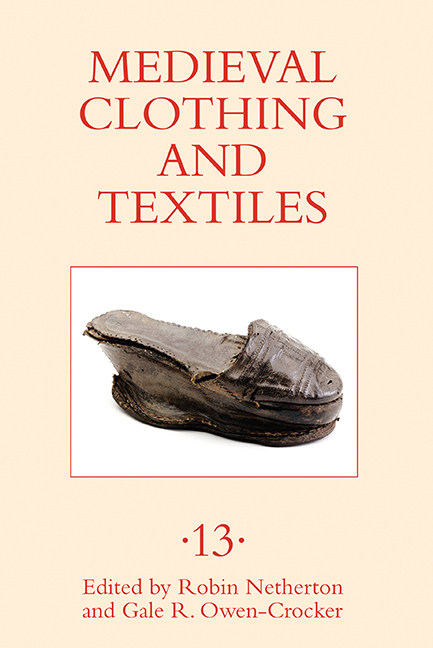Book contents
- Frontmatter
- Contents
- Illustrations
- Tables
- Contributors
- Preface
- 1 The Significance of Dress in the Bayeux Tapestry
- 2 How Long Is a Launce? Units of Measure for Cloth in Late Medieval Britain
- 3 Robes, Turbans, and Beards: “Ethnic Passing” in Decameron 10.9
- 4 Calciamentum: Footwear in Late Medieval Lucca
- 5 “Bene in ordene et bene ornata“: Eleonora d’Aragona’s Description of Her Suite of Rooms in a Roman Palace of the Late Fifteenth Century
- 6 The Lübeck Wappenröcke: Distinctive Style in Fifteenth-Century German Fabric Armor
- Recent Books of Interest
- Contents of Previous Volumes
Preface
Published online by Cambridge University Press: 12 August 2020
- Frontmatter
- Contents
- Illustrations
- Tables
- Contributors
- Preface
- 1 The Significance of Dress in the Bayeux Tapestry
- 2 How Long Is a Launce? Units of Measure for Cloth in Late Medieval Britain
- 3 Robes, Turbans, and Beards: “Ethnic Passing” in Decameron 10.9
- 4 Calciamentum: Footwear in Late Medieval Lucca
- 5 “Bene in ordene et bene ornata“: Eleonora d’Aragona’s Description of Her Suite of Rooms in a Roman Palace of the Late Fifteenth Century
- 6 The Lübeck Wappenröcke: Distinctive Style in Fifteenth-Century German Fabric Armor
- Recent Books of Interest
- Contents of Previous Volumes
Summary
2016 was the 950th anniversary of the Battle of Hastings and the Norman Conquest of England, precipitating commemorations and conferences on both sides of the English Channel. It is fitting, therefore, that we should publish a chapter on the Bayeux Tapestry, a product of the Anglo-Norman period which depicts events leading up to the Conquest and the Battle itself. Gale R. Owen-Crocker accordingly examines “The Significance of Dress in the Bayeux Tapestry.” The Tapestry, one should not forget, is a wall hanging, a decorative furnishing fabric for a room, albeit a very large one. Furnishings are also the topic of “‘Bene in ordene et bene ornata’: Eleonora d’Aragona's Description of Her Suite of Rooms in a Roman Palace of the Late Fifteenth Century,” Jane Bridgeman’s discussion of an aristocratic bride's letter home in which she enumerates the splendours of the apartment prepared for her as a guest of the pope in Rome.
The later medieval period saw a meteoric rise in the cloth trade, with fabrics for all levels and purposes, which was accompanied by an explosion of terminology to describe, measure, and market it. In “How Long Is a Launce? Units of Measure for Cloth in Late Medieval Britain,” Mark Chambers examines terminology for cloth and fur measures in the late medieval British Isles, demonstrating the multilingual nature of business writing of the period. Commerce and its vocabulary feature again in Christine Meek's “Calciamentum: Footwear in Late Medieval Lucca,” a product of this author's ongoing study of the records of this Tuscan city (see Medieval Clothing and Textiles volumes 7 and 10), which gives a vivid picture of the variety of shoes, pattens, soled hose, and other footwear briskly produced and frequently purchased in this prosperous Italian centre. Everybody needed footwear, and references to it in the city records are frequent. In contrast, Jessica Finley's article “The Lübeck Wappenröcke: Distinctive Style in Fifteenth-Century German Fabric Armor” deals with a relatively rare item of clothing, the contemporary name of which is not known. Finley works from surviving examples and extant illustrations to establish how these defensive garments were made and assembled.
As readers of this journal recognize, medieval dress was a prominent indicator of identity, including gender, rank, and ethnicity. For this reason disguise is a device beloved of late medieval authors.
- Type
- Chapter
- Information
- Medieval Clothing and Textiles 13 , pp. xii - xivPublisher: Boydell & BrewerPrint publication year: 2017



